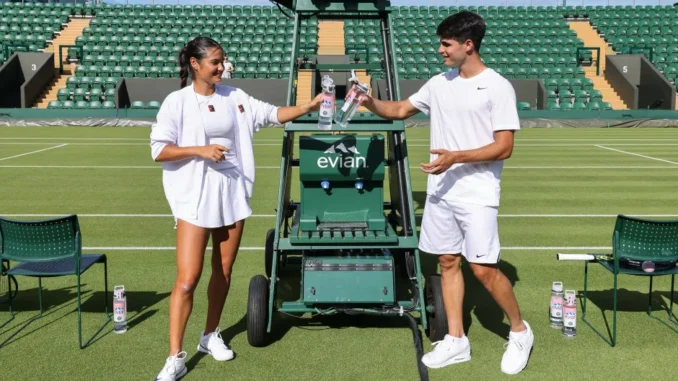
The 2025 US Open is set to kick off with a electrifying twist, as the mixed doubles event undergoes a dramatic overhaul, featuring six bold new rules designed to inject star power and intensity into Flushing Meadows. Leading the charge is the blockbuster pairing of Britain’s Emma Raducanu, the 2021 US Open champion, and Spain’s Carlos Alcaraz, a five-time Grand Slam winner. Their first-round clash against top seeds Jessica Pegula and Jack Draper, scheduled for Tuesday, August 19, 2025, at Arthur Ashe Stadium, promises to be a spectacle, with a $1 million prize awaiting the champions—a fivefold increase from last year’s $200,000. Yet, the revamped format has sparked heated debate, with doubles specialists decrying it as a “pseudo-exhibition” that sidelines their craft.
The new-look mixed doubles, condensed into a two-day event on August 19 and 20, shifts to the week before the main singles draw, a move inspired by the success of last year’s Mixed Madness fan event. Matches will unfold on the grand stages of Arthur Ashe and Louis Armstrong Stadiums, drawing thousands of spectators during what’s typically a quieter Fan Week. The 16-team field, halved from the traditional 32, comprises eight pairs based on combined singles rankings and eight wildcard entries, prioritizing high-profile singles stars like Novak Djokovic with Olga Danilovic, Iga Swiatek with Casper Ruud, and Naomi Osaka with Gael Monfils. Raducanu and Alcaraz, granted a wildcard, embody the event’s star-driven ethos. “I’m super excited about it. I think it’s going to be great,” Alcaraz said after his Queen’s Club win, revealing he approached Raducanu through their agents. “We will try to win. But obviously, it’s going to be really, really fun.”
The six new rules redefine the competition’s structure. First, the draw is limited to 16 teams, amplifying the stakes. Second, entry is determined by singles rankings or wildcards, sidelining doubles specialists—only defending champions Sara Errani and Andrea Vavassori represent the doubles elite. Third, matches (except the final) are best-of-three sets played to four games, not six, with a tiebreak at 4-4. Fourth, no-advantage scoring means deuce leads to a sudden-death point, heightening drama. Fifth, a 10-point tiebreak replaces a third set if matches are tied at one set apiece. Finally, the final reverts to traditional six-game sets but retains no-ad scoring and a 10-point tiebreak decider. “It’s going to count as a real Grand Slam. The prize money is great,” said Taylor Fritz, paired with Elena Rybakina, reflecting the allure for singles stars. Frances Tiafoe echoed, “Seeing the prize money, everyone was like, ‘We’re going, no matter what.’”
This format, however, has drawn sharp criticism. Errani called it “sad” and “nonsense,” arguing, “It would be like if, at the Olympics, they didn’t let the actual high jumpers participate, and instead had basketball players compete in the high jump because it’s more ‘interesting.’” Doubles veteran Jamie Murray noted, “People are obviously excited, because it’s the best men and women on court together, which is a cool product. But a lot of doubles players are annoyed.” Wimbledon doubles champion Henry Patten added, “It’s a shame that the format is very short and the draw is really diminished. I think to be calling it a Grand Slam is ridiculous.” The exclusion of specialists like Wimbledon mixed doubles champion Sem Verbeek, who lamented, “As a doubles athlete, my heart is bleeding,” underscores the tension.
Scheduling woes further complicate the event. Alcaraz, fresh off a grueling Cincinnati Open final on August 18, faces a 600-mile private jet dash to New York, admitting, “The scheduling is not the best to be honest, playing tomorrow. Probably going to sleep late but I will try to put my best tennis to help Emma get the win.” Withdrawals by Coco Gauff, Aryna Sabalenka, and others, alongside doubts over Jannik Sinner’s participation after illness, highlight the logistical strain. Jack Draper, now on his third partner after Paula Badosa and Zheng Qinwen pulled out, remains optimistic: “I think it’s a good format to get prepared for the US Open.”
For Raducanu, the event is a chance to shine on a court where she made history at 18. Her recent coaching changes and a 2024 Eastbourne win over Pegula signal a resurgence. Alcaraz, calling her “the boss,” is eager to leverage their “genuine connection” forged through shared sponsors and off-court interactions. As they face Pegula and Draper at approximately 2 p.m. ET (7 p.m. BST) on Tuesday, broadcast on ESPN and Sky Sports Tennis, the tennis world awaits a clash that could redefine mixed doubles—or spark further debate about its Grand Slam status.
Leave a Reply